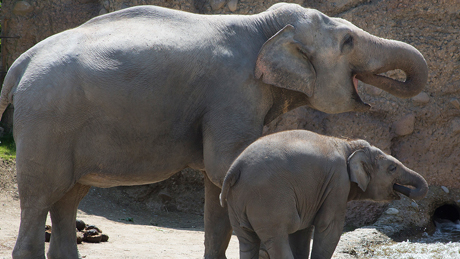Elephant Herpes: Super-Shedders Endanger Young Animals

It is important to test elephants in zoos regularly for herpes. Picture: Zoo Zurich
Many herpesviruses infect only a few animal species. Elephants also have their own spectrum of herpesviruses, which can cause infections that end in death. Asian elephants are carriers of virus types1, 4 and 5, while African elephants carry types 2, 3 and 6.
Type 1 is particularly dangerous for young Asian elephants and has led to numerous deaths in the wild and in zoos worldwide. In Switzerland as well, three animals have died of “Elephant Herpes” in the last 30 years. How the elephants transmit the disease, however, and how they become infected, has been largely unknown until now.
Samples obtained from trunk washing
For some time, researchers have been able to use trunkwash samples to find out whether elephants are affected by the virus and whether they are shedding it. “Elephants can be trained to have their trunks flushed with a physiologic salt solution,” Jean-Michel Hatt, director of the Clinic for Zoo Animals, Exotic Pets and Wildlife at UZH, explains. “In the process, they lift their trunks briefly so that the liquid can flow to the back as far as possible and then they drain it into a bucket.” The samples gained in this manner were tested for herpesviruses at the UZH Institute for Virology.
Virulent super-shedders
“The elephants we examined can be divided into ones that do not shed the virus or only seldom shed it and ones that shed it frequently,” says virologist Mathias Ackermann. “The latter are so-called super-shedders which cause the majority of the infections.” Super-shedders are known for causing other viral infections among both humans and animals. They themselves are immune to the disease and pass on this immunity to their offspring.
Risky contact with young animals
The situation becomes dangerous when a super-shedder comes into contact with the juveniles of non-shedders. An elephant cow which shed the virus most frequently during the study, for example, was in very close contact with all three elephant calves that died of the virus in Switzerland. All calves carried virus sub-type 1A responsible for the deaths, which indicates a shared source of infection. The dead animals were the offspring of non-shedders, while the progeny of the super-shedder were not affected.
Wide-spread disease
“Elephant herpes is not just a zoo disease,” Mathias Ackermann says. The herpesviruses of elephants broke off from other herpesviruses at the same time elephants split from other mammals. Since then, the Asian and African virus types have developed even further apart from each other. The individual types vary in virulence, but both are wide spread in their countries of origin. The disease also occurs in the wild in Asia and in Africa.
Regular testing is key
The researchers from Zurich are convinced: “It is important to test elephants in zoos regularly for herpes.” The placement of animals can then be planned so that elephant calves are at less risk. By testing blood for the virus, a breakout of the disease among juveniles can be determined much earlier, extending the treatment period by up to ten days.
Literature:
Ackermann M, Hatt J-M, Schetle N, Steinmetz HP: Identification of Shedders of Elephant Endotheliotropic Herpesviruses Among Asian Elephants (Elephas maximus) in Switzerland. May 3, 2017. PLoS One. DOI: pone.0176891
Contact:
Prof. Dr. Jean-Michel Hatt
Clinic for Zoo Animals, Exotic Pets and Wildlife
Vetsuisse Faculty
University of Zurich
Phone: + 41 44 635 83 42
E-mail: jmhatt@vetclinics.uzh.ch
Media Contact
All latest news from the category: Agricultural and Forestry Science
Newest articles

NASA: Mystery of life’s handedness deepens
The mystery of why life uses molecules with specific orientations has deepened with a NASA-funded discovery that RNA — a key molecule thought to have potentially held the instructions for…

What are the effects of historic lithium mining on water quality?
Study reveals low levels of common contaminants but high levels of other elements in waters associated with an abandoned lithium mine. Lithium ore and mining waste from a historic lithium…

Quantum-inspired design boosts efficiency of heat-to-electricity conversion
Rice engineers take unconventional route to improving thermophotovoltaic systems. Researchers at Rice University have found a new way to improve a key element of thermophotovoltaic (TPV) systems, which convert heat…



